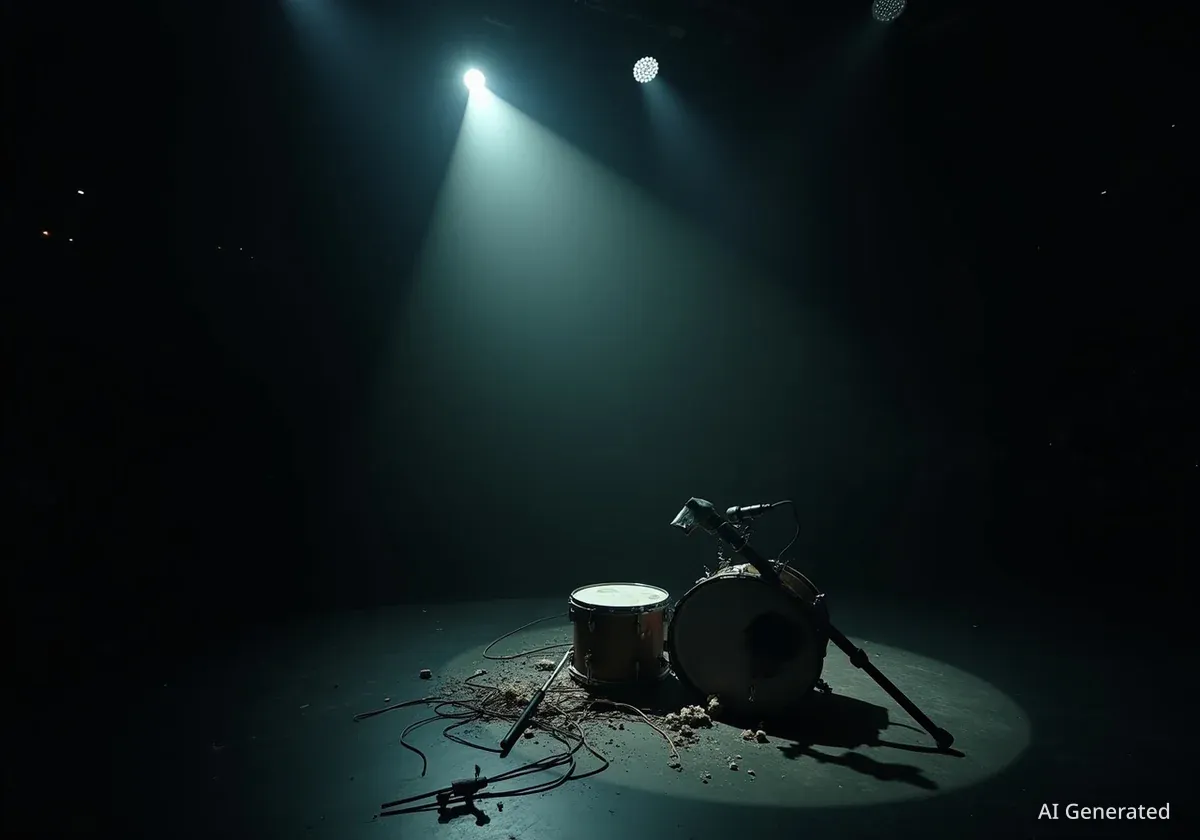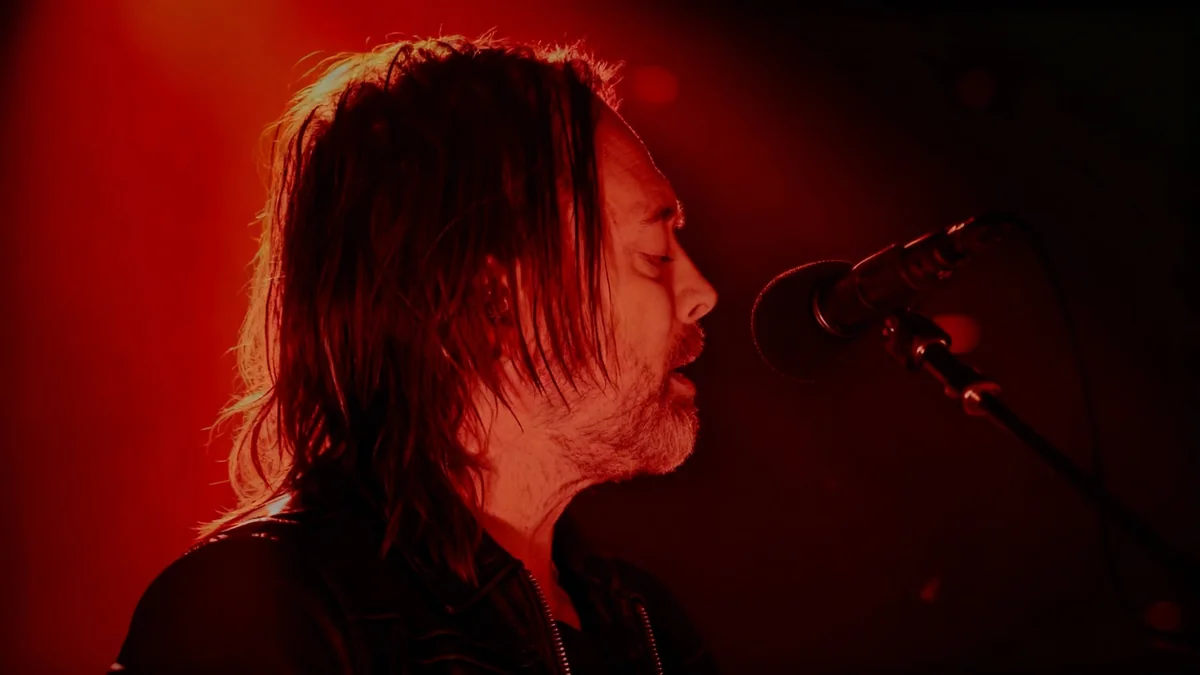Idaho-based band Extortionist has released their fourth full-length album, "Stare into the Seething Wounds," via Unique Leader Records. The album, which was released on October 10, 2025, continues the band's exploration of a hybrid sound that merges the atmospheric textures of nu-metal with the intense aggression of modern deathcore.
Spanning 48 minutes, the record presents a stark contrast between two distinct musical approaches. One side features clean, melodic passages influenced by 90s alternative and nu-metal, while the other delivers heavy, breakdown-focused deathcore. This stylistic duality defines the listening experience, raising questions about the album's overall cohesion and execution.
Key Takeaways
- Extortionist's fourth album, "Stare into the Seething Wounds," attempts to fuse nu-metal, grunge, and deathcore.
- The album is characterized by a sharp division between atmospheric, melodic sections and aggressive, breakdown-heavy parts.
- Vocalist Ben Hoagland employs a dual style, shifting between a drawling baritone reminiscent of 90s nu-metal and aggressive deathcore roars.
- The production features a distinctive snare sound, reportedly supplemented by striking a metal keg, which contributes to an overfilled and often clashing mix.
- While the album showcases technical proficiency, its lengthy runtime and repetitive structure result in a monotonous and disjointed listening experience.
A Sound Defined by Duality
Extortionist has carved out a niche by blending genres that often exist in separate corners of the heavy music landscape. "Stare into the Seething Wounds" pushes this concept further, creating an album built on a foundation of contrasts. The core of the record oscillates between two primary modes: one rooted in the atmospheric and melodic sensibilities of nu-metal and grunge, and another that embraces the sheer force of contemporary deathcore.
This approach is immediately apparent in the album's structure. Tracks frequently shift from hazy, effects-laden guitar passages and subdued vocals to sudden, high-impact breakdowns. While this formula can create moments of surprise, its repeated use across the album's 48-minute duration leads to a predictable pattern that can diminish the impact of these transitions.
The band draws from a wide range of influences. The nu-metal sections evoke the sound of pioneering acts like Korn and the moodier textures of Alice in Chains. In contrast, the heavier segments align with the modern brutality of bands such as Bodysnatcher and The Last Ten Seconds of Life.
An Analysis of the Nu-Metal Elements
A significant portion of "Stare into the Seething Wounds" is dedicated to its more subdued and atmospheric side. These sections are defined by watery guitar effects, minor-key progressions, and a vocal style that directly channels the nu-metal era. Vocalist Ben Hoagland adopts a drawling baritone that closely mirrors the delivery of Jonathan Davis from Korn.
The Nu-Metal Revival
In recent years, many contemporary metal bands have begun incorporating elements of nu-metal, a genre that dominated the late 1990s and early 2000s. This revival often involves blending nu-metal's distinct vocal styles, rhythmic patterns, and guitar effects with modern metalcore and deathcore production, creating a hybrid sound for a new generation of listeners.
Tracks like "The Break I Couldn’t Mend," "Submit to Skin," and "Dopamine" are prime examples of this approach. They prioritize creating a sonic haze, with layers of opaque instrumentals that aim for a sound reminiscent of bands like Deftones. However, the execution often falls short of its potential.
The primary issue with these sections is a lack of dynamic progression. The transitions from quiet, melodic passages to heavy chugs are abrupt, with Hoagland's vocal shift being the main indicator of the change. The instrumental layers rarely build tension or crescendo organically, resulting in a start-stop dynamic that feels disjointed rather than fluid.
While the sonic goal appears to be a fusion of influences like "Freak on a Leash" and "Come As You Are," the songwriting lacks the charisma and structural depth to make these moments compelling. Instead, they often function as interludes between the album's more aggressive segments, slowing the momentum without adding significant emotional weight.
The Deathcore and Metalcore Foundation
When "Stare into the Seething Wounds" shifts into its heavier gear, it delivers a more straightforward brand of aggression. This side of the band's sound is rooted in deathcore and metalcore, characterized by thick, down-tuned riffs and bone-crushing breakdowns. These moments are designed for high energy and physical impact, recalling the intensity of acts like Alpha Wolf and early Crystal Lake.
Tracks such as "Aftermath of Broken Glass" and "Detriment" showcase the band's capability in composing solid, high-impact metalcore. The riffs are fast, the drumming is powerful, and the breakdowns are punishing. However, even within these more focused tracks, the album struggles with originality. The compositions, while technically proficient, offer little to distinguish Extortionist from a crowded field of similar-sounding bands.
Signature Drum Production
A notable aspect of Extortionist's sound is the unique drum production, particularly the snare tone. Drummer Vince Alvarez is known for supplementing the conventional snare sound by striking a metal beer keg with a baseball bat. While distinctive, this highly reverberant sound contributes to a mix on this album that often feels cluttered and clashes with the dense guitar tones during breakdowns.
Furthermore, some of the heaviest moments are hampered by minor execution issues. On tracks like "Cycle of Sin" and "Starve," there are noticeable timing disparities between the vocal callouts preceding a breakdown and the instrumental impact itself. These slight tempo inconsistencies can disrupt the rhythmic force that is crucial for this style of music.
"The album's stark dichotomy of grungy drawling and brutalizing breakdowns ultimately boils down to a monotonous experience. If you ever forget this is deathcore, a ten-ton breakdown will remind you."
Vocal Performance and Production Choices
Ben Hoagland's vocal performance is central to the album's divided personality. His ability to switch between the Jonathan Davis-esque drawl and belligerent deathcore roars is technically impressive. However, the constant back-and-forth becomes a predictable gimmick. Off-beat growls and ad-libs are used frequently to signal the nu-metal influence, but they often feel forced rather than integrated into the music.
The production, handled in part by drummer Vince Alvarez, is another key factor. The signature keg-enhanced snare sound, combined with heavy reverb, creates an inflated and busy mix. During the album's most intense moments, this production choice can work against the music, causing the breakdowns and riffs to feel buried under a wash of sound rather than hitting with clarity and precision.
Ultimately, "Stare into the Seething Wounds" is an album with a clear concept that struggles in its execution. The 48-minute runtime feels bloated, as the two competing styles fail to merge into a cohesive whole. Instead, they exist in opposition, creating a repetitive cycle of quiet and loud that becomes tiresome. While individual moments may appeal to fans of either nu-metal or deathcore, the album as a complete work is unlikely to satisfy those seeking a well-integrated and innovative fusion of the two.




